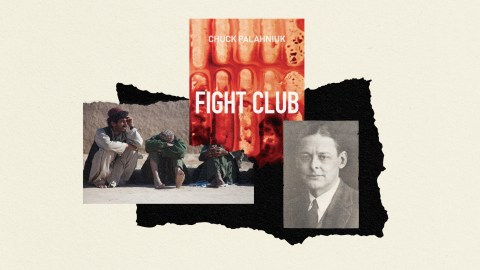5 brilliant books told in the second-person perspective

- It’s relatively rare to find a book written in the second-person perspective.
- That’s maybe no surprise, given that reading a book where “you” are the main character can be a strange experience, not to mention a tough literary feat for the author.
- From Fight Club to Romeo and/or Juliet, these five novels manage to successfully utilize this tricky narrative device.
If you grab any novel from the fiction section of your bookstore, odds are the story is told in the first- or third-person perspective. It’s relatively rare to find the second-person point of view. That’s where the author invites you, the reader, directly into the story, guiding your journey as the protagonist with “you” as the primary pronoun. It’s a unique narrative style that can create an intense, immersive experience, blurring the lines between reader and character, allowing you to step into the narrative and live out the storyline.
But this technique can be challenging to wield effectively. It demands precision and a deep understanding of human nature to ensure it resonates with the reader. Here, we list five books that do just that.
Earth and Ashes by Atiq Rahimi
Earth and Ashes is a 2000 book by Atiq Rahimi. A mere 81 pages long, the book follows an older man, Dastaguir, going to give his son news after an air attack by the Soviets on the Afghan village where his family lived. Dastaguir’s grandson, deaf as a result of the bombing, tags along, unable to fully understand what’s going on. The novel gives faces, dates, and history to part of the world that is often reduced to a series of negative adjectives.
The second-person approach is a reference to the style of a great deal of Dari language poetry. To readers unfamiliar with the technique, it can be rather jarring. It at once allows us to get closer to the main character than other forms of narration while, at the same time, forcing readers to engage with the story on its own terms.
The author made the book into a film in 2004.
Fight Club by Chuck Palahniuk
“Tyler gets me a job as a waiter, after that Tyler’s pushing a gun in my mouth and saying, the first step to eternal life is you have to die.”
So begins the 1996 novel Fight Club, written by Chuck Palahniuk. The story explores questions of meaning, masculinity, consumerism, and identity as they appeared to a generation that was raised on television and promised the end of history. Sure, the first rule of Fight Club is that “You do not talk about Fight Club,” but doing so provides us an interesting way to explore the second-person narrative form.
Although much of the story is written in the first person, the novel features frequent refrains in the second person that Mr. Palahniuk has referred to as “choruses.” These serve a similar function to a Greek choir: Repeating sections all beginning with or addressed to “you” reflect on the major themes of the novel and pull the reader into the story. When reading the novel, you are not just an observer of two people having a conversation about how “You are not your job.” Rather, they are talking to you. The problems facing the characters are issues you — as a person stuck living in a modern, consumerist society — must face.
The second-person narration also aids in the construction and delivery of the novel’s famous twist. A film version of the novel came out in 1999.
The Diver’s Clothes Lie Empty by Vendela Vida
The Diver’s Clothes Lie Empty is a 2015 novel by Vendela Vida. In the story, an unnamed protagonist loses her possessions and papers while visiting Casablanca. As she attempts to remedy the situation, things get stranger and stranger. It addresses questions of identity, self, and freedom.
The protagonist is addressed as “you” by the narrator, and often by other characters. Even the descriptions of her life are presented as statements such as, “You attended an expensive all-girls school on scholarship.” As the plot thickens, the use of the second person asks the reader if they would do what “You” does. As she switches identities as they become available, the protagonist’s attempts to separate herself from herself, as well as a few menacing characters, lead us to ask ourselves what’s in a name and how we can change ourselves — if we can at all.
The title itself is a reference to a poem by the Persian poet Rumi, suggesting that the identity of the book itself is a malleable thing.
The Waste Land by T.S. Elliot
The Waste Land is a modernist poem by T.S. Elliot. It is often regarded as the finest example of modernist poetry and a contender for the title of greatest English language poem of the 20th century. Its opening line, “April is the cruelest month,” is known even by many who have never read it. While it is possible to pull countless themes out of the heap of broken images Elliot provides, some of the more commonly listed ones include fragmentation, disillusionment, how directionless the world seemed in the aftermath of WWI, death, and rebirth.
The use of second-person narration in The Waste Land is in support of a larger set of narratives, in another style. Elliot, as part of his use of constantly shifting points of view in the poem, features the use of the second person in the first, fourth, and fifth sections of his masterpiece.
It is argued by Amy Hume, formerly of Ohio University, that this leads to The Waste Land becoming an epic poem starring the reader. There are no heroes in the titular wasteland, only personalities providing their perspectives and guidance. The sections that directly address the reader, including the one calling you a hypocrite, are meant to pull you in — to provide a possible route down the hero’s path that’s familiar in other epic poems. However, given that this is a wasteland, no wise older man will guide you.
Elliot refused to speculate on the meaning of the poem, leaving that as an exercise for the reader.
Romeo and/or Juliet by Ryan North
Given the comparative rarity of second-person narration, most readers are likely familiar with it only from a few sources. For readers over a certain age, that was likely in the form of Choose Your Own Adventure-style books. In this 2016 offering by Ryan North (and, technically, the sometimes hated William Shakespeare), the reader can dive directly into one of the most famous stories in English literature and change it as they see fit.
Told in the second person, the reader is actively making decisions that drive the plot. It allows for a few substantial changes to the story we all read in English class. It’s probably best to warn you, however, that you’ll probably still die at the end. It is a tragedy, after all.





